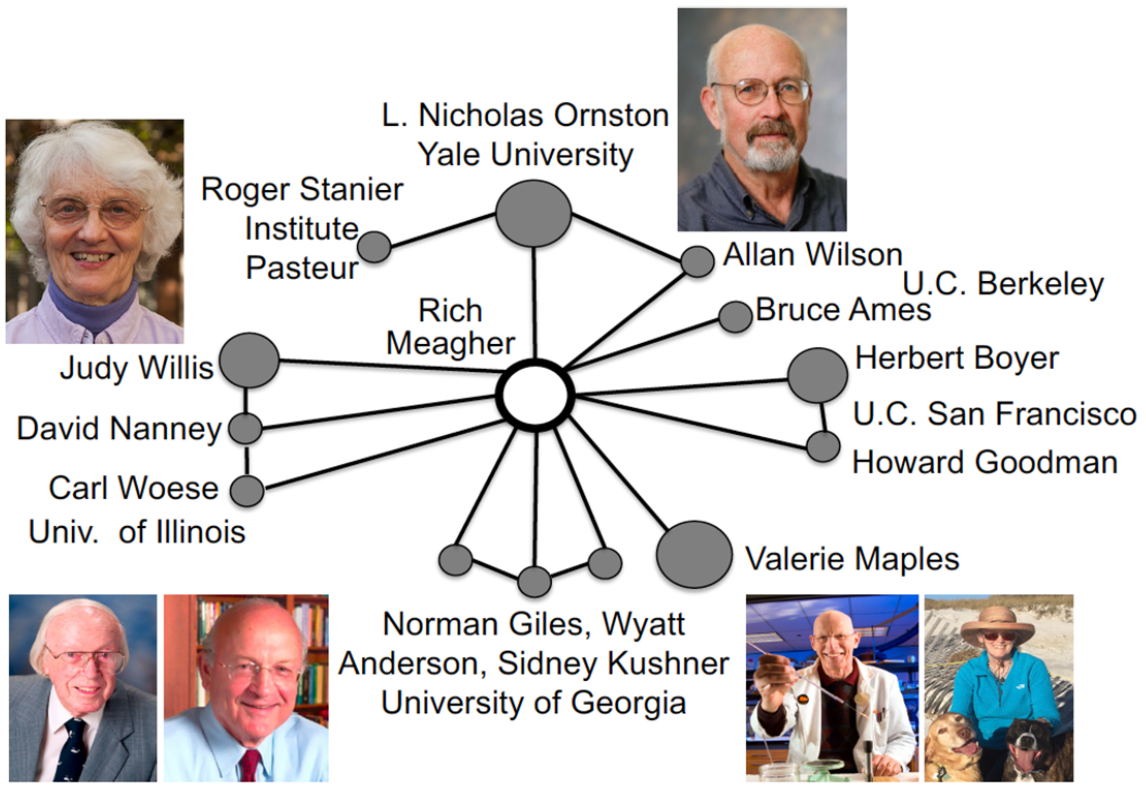Rich’s scientific interaction network
A science interaction network of the people who most influenced my development
I had an exceptional undergraduate research experience at the University of Illinois, Champaign, carrying out three years of research with Professors Roderick McCleod and Elie Reichmann, often working in Sol Speigelman’s lab, and with help from outstanding postdocs. Here I learned a wide variety of cell biological and biochemical techniques such as fluorescence microscopy, ultracentrifugation, affinity and fluorescent tagging of proteins and viruses, and electrophoresis of RNA and protein. Unbeknownst to a naïve undergrad, these were all new technologies at the time. I was wisely advised by Professors Judy Willis and David Nanney. They encouraged me by praising my accomplishments in the classroom and laboratory and politely pointed out my weaknesses with suggestions how do address them. In 1966, when I was nineteen years old, Dr. Willis first described to me what an academic research scientist and teacher did with their life. At that moment I knew what my career would be. Professor Carl Woese advised me that if I wanted long exciting career in biology I should chose the fields of molecular biology and genetics, because the problems were so complex and interdisciplinary that I would not peak intellectually until my 50 or 60s. My biology and biochemistry course work was demanding and I learned how to stay focused, studying only one problem at a time. I only later, when I began graduate school, did I realize how well my U of I experiences had equipped me for a PhD and a research career.
I spent some of the most enjoyable years of my life earning my M. Phil. and Ph.D. degrees in Professor L. Nicholas Ornston’s laboratory at Yale University. In Dr. Ornston’s lab I learned the necessity of combining genetics, evolutionary biology, biochemistry, and chemistry to solve biological problems. By example, Dr. Ornston taught me the value of short daily lessons with students to deliver new concepts and discuss experimental problems. In 1969, at a black board, Dr. Ornston outlined for me, that the evolution of enzymes and macroevolution of complex biochemical properties proceeded via gene duplication and mutation. This was at the time only an untested hypothesis with essentially no solid experimental evidence. Were we ever so unenlightened? This concept remains a life-long passion. Now, 50 years later, many of the mechanisms of molecular evolution are being worked out in great detail with thousands of published articles.
My first postdoctoral study was with, Professor Bruce Ames at U.C. Berkeley, a stimulating and creative individual, who taught me to think about the power of positive genetic selections and screens. During my second postdoc, my advisors Professors Herbert Boyer and Howard Goodman at U.C. San Francisco Medical School gave the opportunity begin working in the fledgling field of molecular cloning of DNA. While I was there, with help from colleagues I cloned the first plant genes and expressed them in E. coli. This work rivaled the first cloning and expression human genes, by this team the same year. This was a big break, not only giving me a life time of possible novel projects, but the training and credentials I needed to find an excellent faculty job at a top university.
These several above-mentioned individuals greatly stimulated my love of science and prepared me for a career of teaching and research. They are also responsible for the broad training I received, which has served me well as I have changed my research focus several times. Since I joined the Genetics Group at the University of Georgia in 1976 and the Genetics Faculty in 1980, I’ve studied the plant actin cytoskeleton, RNA and purine metabolism, phytoremediation, chromatin remodeling, obesity, cell-type specific epigenetic reprogramming in blood, brain, and adipose tissues, obstructive sleep apnea, and antifungal therapeutics. I have had a lot of support from my colleagues at UGA and the University, and that is a major reason I have remained at UGA from my entire professional career. In the firsts several years of establishing a successful research laboratory at UGA I made many mistakes and needed the encouragement and direction I got from my colleagues, and particularly from Professors Normal Giles, Wyatt Anderson, and Sidney Kushner. Finally, I must mention my wife Valerie Maples, an outstanding scientist in her own right. Over the last 40 years she provided the personal support and advice that gave direction to my life and career.

